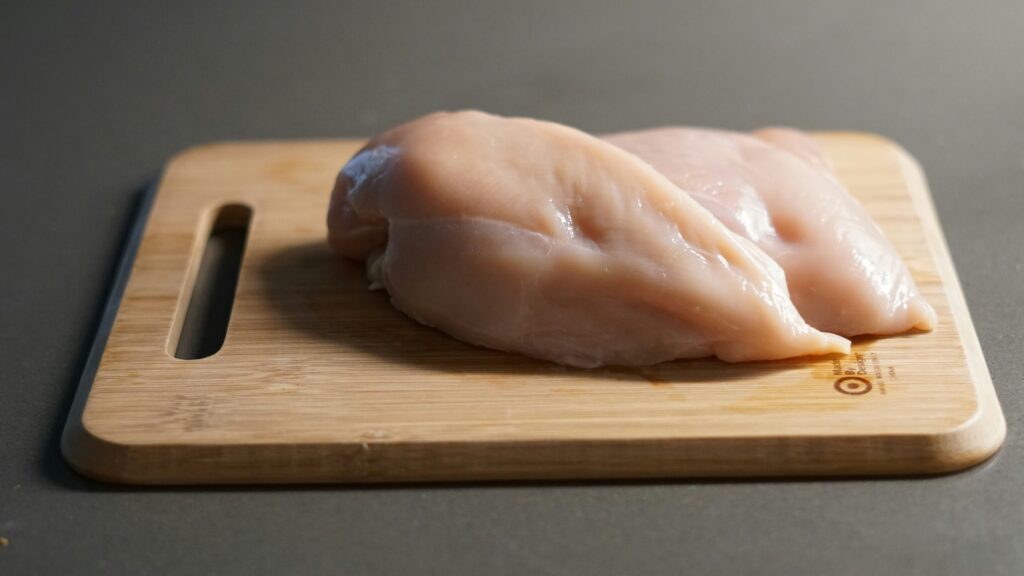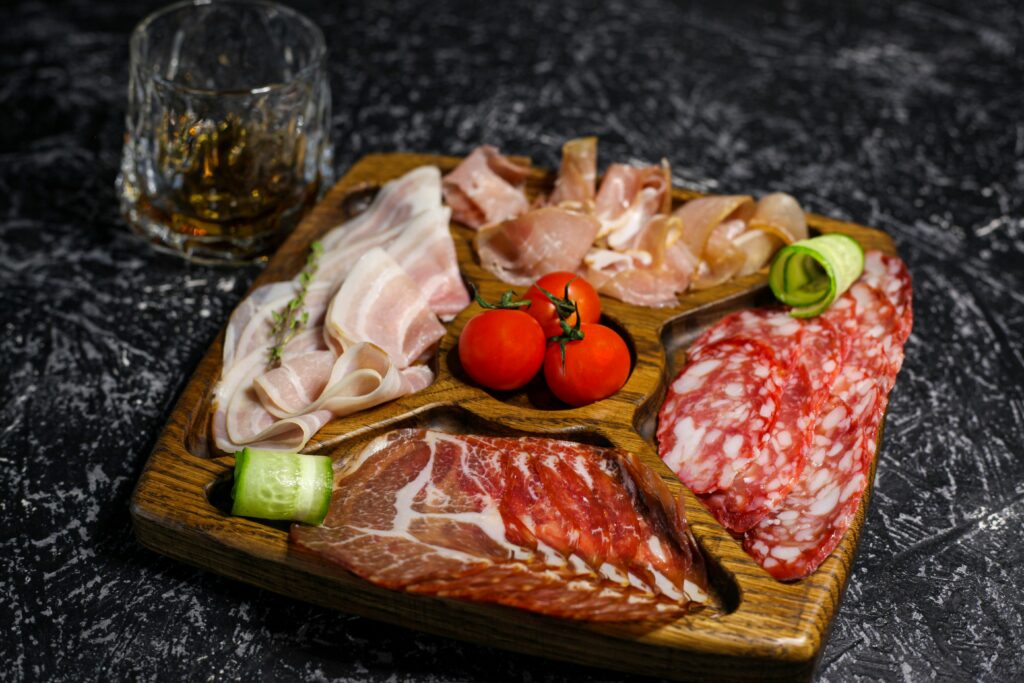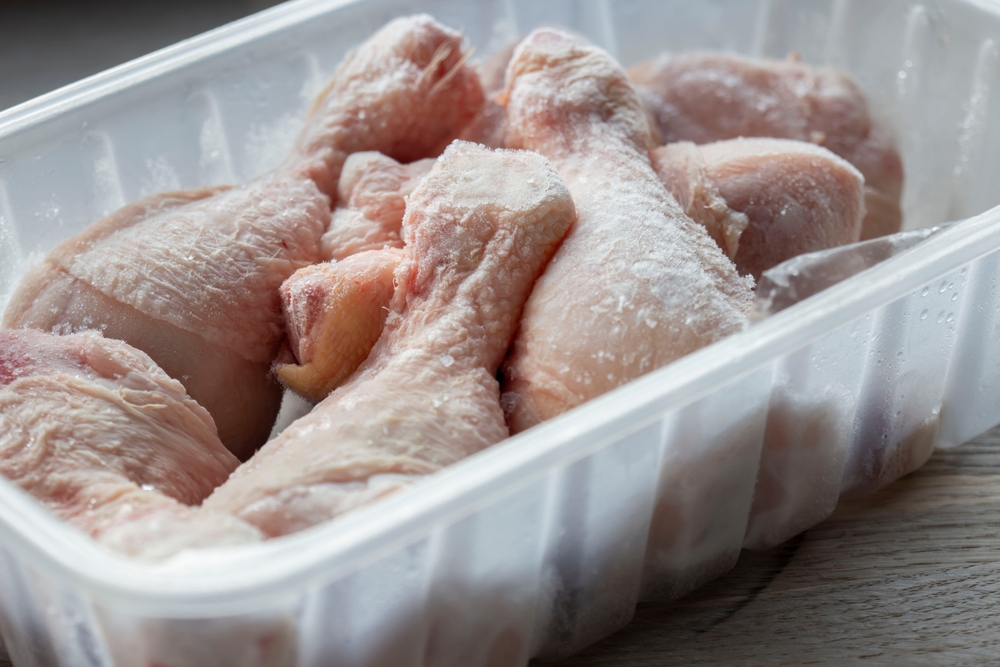Defrosting food on the counter may seem convenient, but it puts your health at risk. At room temperature, frozen food quickly enters what is known as the “danger zone,” the range where bacteria multiply at unsafe levels. Some foods are especially vulnerable to contamination when thawed this way, and eating them afterward can lead to serious illness. The safest methods include thawing in the refrigerator, under cold water, or in the microwave. Here are nine foods you should never leave out on the counter to defrost.
Raw Chicken
Chicken is one of the most dangerous foods to thaw on the counter because it encourages the rapid growth of bacteria. The outer layers of chicken begin warming up long before the inside has fully defrosted. This uneven thawing allows bacteria such as Salmonella or Campylobacter to multiply on the surface while the core remains frozen solid. The safest option is to thaw chicken in the refrigerator, where the entire cut stays at a consistent cold temperature. If you need it ready faster, cold water thawing works, but the water must be changed regularly to stay cold. Keeping chicken out of the danger zone is the only way to make sure it remains safe to cook and eat.

Ground Beef
Ground beef is particularly risky to thaw at room temperature because of its structure. Unlike a whole steak or roast, ground meat has more surface area exposed to air. That means bacteria can grow faster across the outer layers when the meat sits on the counter. As the exterior softens, it can reach unsafe temperatures while the middle is still hard and icy. This creates the perfect environment for contamination. The best way to defrost ground beef is in the refrigerator, which may take up to 24 hours for larger packages. If speed is important, sealed packages can be placed in cold water, but they must be cooked immediately once thawed to stay safe.
Fish and Seafood
Seafood is one of the most perishable foods and should never be left to thaw on the counter. The delicate structure of fish, along with its high moisture content, makes it spoil more quickly than other proteins. When seafood sits out, the surface warms up rapidly while the inside remains frozen, causing uneven thawing. Shrimp, scallops, clams, and mussels are even more sensitive because they deteriorate faster than fish fillets. Leaving them on the counter not only raises safety concerns but also reduces their texture and flavor. The safest practice is to defrost seafood in the refrigerator, where it stays cold and fresh, or by placing it in a sealed bag under cold running water if you need it ready within a few hours.
Pork
Pork is another food that should never be thawed on the counter because of its high risk for contamination. Cuts such as pork chops, roasts, or tenderloin might look safe while thawing, but the surface temperature rises into the danger zone much faster than the core. Once bacteria begin growing, the risk continues even if the pork is later cooked, since toxins can develop that heat cannot fully remove. Defrosting pork in the refrigerator ensures it stays at a safe temperature throughout the process. For faster thawing, submerging sealed pork in cold water can work, but you should cook it right away to maintain food safety. This method keeps pork tender while preventing unnecessary exposure to harmful bacteria.
Eggs in Their Shells
Eggs are rarely frozen on purpose, but it can happen when they are stored in the freezer by mistake. Defrosting eggs on the counter is unsafe because as they thaw, bacteria can enter through tiny cracks in the shell. Once the interior warms up, bacterial growth accelerates and makes the egg unsafe to eat. The safest method is to defrost eggs in the refrigerator, which allows the inside to warm up slowly without exposure to room temperature. Another option is to use already cracked eggs frozen outside their shells, but even then they should only be thawed in the refrigerator and never on the counter. This preserves freshness and reduces the chance of contamination.
Cooked Leftovers
Cooked leftovers might seem safe to thaw on the counter since they were previously heated, but they are actually more prone to bacteria than raw food. Prepared meals like casseroles, pasta dishes, or cooked meats contain a variety of nutrients that bacteria thrive on. When thawed at room temperature, the outer portion of the dish quickly reaches unsafe conditions while the inside remains frozen. The best way to thaw leftovers is in the refrigerator, which keeps the entire dish safe until you are ready to reheat it. If time is limited, small portions can be defrosted in the microwave, but they should be eaten immediately after reheating.
Deli Meats

Deli meats such as sliced turkey, ham, roast beef, or bologna are often processed and may contain preservatives. Once they are exposed to room temperature during thawing, they quickly become unsafe to eat. The moist environment inside packaged deli meat encourages rapid bacterial multiplication. Leaving them on the counter can also affect their texture and cause them to spoil faster. Refrigeration is the safest method, and it also helps maintain the original flavor and quality of the meat. If deli meats are vacuum sealed, they can be thawed in cold water, but they should be eaten shortly afterward.
Dairy Products
Certain dairy items, including milk, cheese, yogurt, and cream, should never be thawed on the counter because they spoil quickly when exposed to room temperature. Soft cheeses are especially risky because they can grow harmful bacteria in just a few hours outside the fridge. Milk and cream sour rapidly once warmed, making them unsafe to consume and unpleasant in taste. Even harder cheeses, while less perishable, can still develop unsafe conditions when left out too long. Thawing dairy in the refrigerator keeps it cold enough to slow bacterial growth and preserve its original consistency. In some cases, it may still separate slightly after thawing, but it will remain safe if handled properly.
Frozen Meals
Packaged frozen meals might look safe because they are processed and sealed, but thawing them on the counter is not recommended. These meals contain multiple ingredients that thaw at different speeds, creating uneven temperature zones inside the package. Some parts may remain frozen while others reach unsafe temperatures where bacteria can grow. The instructions on frozen meal packaging are designed to keep the food safe, usually recommending microwave or oven cooking directly from frozen. If you prefer thawing, the refrigerator is the only safe option. Following the manufacturer’s instructions ensures the meal heats evenly and reduces the risk of contamination.
Disclaimer: This article was created with AI assistance and edited by a human for accuracy and clarity.

